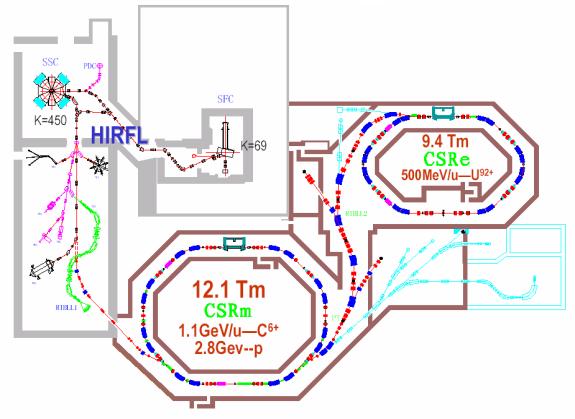With great effort of researchers in Institute of Modern Physics, Chinese Academy of Sciences (IMP), the Cooling Storage Ring at Heavy Ion Research Facility in Lanzhou (HIRFL-CSR) has successfully conducted the carbon ion's super-long-period slow extraction in cancer therapy terminal with the energy of 80MeV/u and 200MeV/u last week.
Fig.1 shows the particle number spectrum during the slow extraction. It proved the ability of HIRFL-CSR to accelerate heavy metal elements, and this is also an important milestone of the advanced heavy ion accelerator HIRFL-CSR. HIRFL-CSR is a new heavy ion cooler-storage ring synchrotron system in Lanzhou, China. It consists of a main ring(CSRm) and an experimental ring (CSRe) with multiusages and multi-functions(see Fig.2).
The C4+ ions, produced by the ECR ion source and accelerated to 7MeV/u by the Sector Focusing Cyclotron (SFC), were stripping injected into the CSR and accumulated to high intensity with the help of electron cooling. After the ions were accelerated to the set energy, a RF-knockout method was used to resonantly slow extract the beam. During the extraction, a feedback system was introduced to modify the time structure of the beam and suppress the ripple and instability. The period of slow extraction was elongated from 1, 3, 20 seconds to 100, 500, 1000, 5000 seconds, and 10000 seconds extraction was finally achieved.
The success of the super long period slow extraction in HIRFL-CSRm verified the ability of synchrotron to provide the high energy quasi-continuous beam. This super long period extraction, with the character of high energy, long duty cycle and adjustable energy, could be of great benefit to the experiment of heavy ion physics in middle and high energy region, Single Event Effect (SEE) of electronic device used in space, material irradiation and other relevant application in bioscience. This is also a key point for the future Heavy Ion Accelerator Facility (HIAF) project of IMP in Lanzhou, China.

Fig.1 the particle number spectrum during the slow extraction (Image by IMP)

Fig.2 the layout of HIRFL-CSR (Image by IMP)

